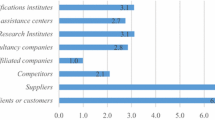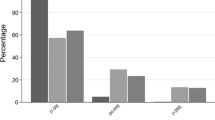Abstract
In this paper we use a size and industry matched sample of over 1,900 UK and US businesses for the period 2004–05 in the manufacturing and business services sectors to analyse the relative “strength” of the university–industry ecosystems in which these firms operate in the two economies. Our analysis shows that in both countries universities per se play a quantitatively smaller role as a source of knowledge for business innovation than either the business sector itself or a variety of organisations intermediating between the university and business sectors. Our analysis reveals a much more diffuse university–industry ecosystem in the UK in which a higher proportion of businesses claim links external to themselves in their pursuit of knowledge for innovation and a higher proportion report directly connecting with universities. US firms are more likely to access knowledge through a combination of business and intermediary sources and are less likely to have established formal collaborative or partnership agreements in the 3 years prior to the survey. We also find, however, that a higher proportion of US firms place a very high value on the connections they have with universities and are much more likely to commit resources to support such innovation related university interactions. A similar pattern of diffuse but weaker links characterise the supply of public sector financial assistance for innovation in our sample firms. UK firms are more likely to be in receipt of assistance, but receive far less per firm in absolute terms and relative to their R&D expenditures. It appears that the UK university–industry ecosystem is characterised by a greater width than quality of interaction.














Similar content being viewed by others
Notes
See Cosh et al. (2006).
References
Branscomb, L. M., & Auerswald, P. E. (2002). Between Invention and Innovation: An Analysis of Funding for Early Stage Technology Development. Washington, DC: US Department of Commerce.
Butchart, R. (1987). A new UK definition of high technology industries. Economic Trends, 400, 82–88.
Cohen, W. M., Nelson, R. R., & Walsh, J. P. (2002). Links and impacts: The impact of public research on R&D. Management Science, 48(1), 1–23. doi:10.1287/mnsc.48.1.1.14273.
Connell, D. (2006). Secrets of the Worlds Largest Seed Capital Fund: How the United States Government uses its Small Business Innovation Research (SBIR) Programme and Procurement Budgets to Support Small Technology Firms, Centre for Business Research. Cambridge, UK: University of Cambridge.
Cooke, P., & Morgan, K. (1998). The Associational Economy: Firms, Regions and Innovation. Oxford: Oxford University Press.
Cosh, A. D., Hughes, A., & Lester, R. (2006). UK PLC just how innovative are we? Cambridge MIT Institute, University of Cambridge, Cambridge, UK. (http://www.cbr.cam.ac.uk/news/160206_Report_only.htm).
Dasgupta, P., & David, P. A. (1994). Towards a new economics of science. Research Policy, 23(5), 487–521. doi:10.1016/0048-7333(94)01002-1.
David, P. A. (2007). Innovation and Europe’s academic institutions–second thoughts about embracing the Bayh-Dole regime. In F. Malerba & S. Brusoni (Eds.), Perspectives on Innovation. Cambridge: Cambridge University Press.
Edquist, C. (2005). Systems of innovation: Perspectives and challenges. In J. Fagerberg, D. C. Mowery, & R. R. Nelson (Eds.), The Oxford Handbook of Innovation. Oxford: Oxford University Press.
Etzkowitz, H. (2002). ‘MIT and the rise of entrepreneurial science’, studies in global competition series. London and New York: Routledge, Taylor & Francis Group.
Etzkowitz, H., Webster, A., Gebhardt, C., Cantisano, T., & Branca, R. (2000). The future of the university and the university of the future: Evolution of ivory tower to entrepreneurial paradigm. Research Policy, 29, 313–330. doi:10.1016/S0048-7333(99)00069-4.
Farrell, D., Baily, M. N., & Remes, J. (2005). US productivity after the dot com bust. UK: McKinsey and Company.
Ferman, J., Porter, M. E., & Stern, S. (2002). The determinants of national innovative capacity. Research Policy, 31, 899–933. doi:10.1016/S0048-7333(01)00152-4.
Hughes, A. (2007). University–industry links and UK science and innovation policy. In S. Yusuf & K. Nabeshima (Eds.), How universities promote economic growth. Washington: The World Bank.
Hughes, A. (2008). Innovation policy as cargo cult: Myth and reality in knowledge-led productivity growth (2008). In J. Bessant & T. Venebles, (Eds.), Creating Wealth from Knowledge. Meeting the Innovation Challenge. Cheltenham: Edward Elgar.
Hughes, A. (2009). Entrepreneurship and innovation policy: Retrospect and prospect. The Political Quarterly (forthcoming).
Laursen, K., & Salter, A. (2006). Open for innovation: The role of openness in explaining innovations performance among UK manufacturing firms. Strategic Management Journal, 27(2), 131–150.
Lazonick, W. (2007). The US Stock Market and the Governance of Innovative Enterprise. Industrial and Corporate Change, 16(6), 983–1035. doi:10.1093/icc/dtm030.
Lerner, J. (1999). The Government as Venture Capitalist: The Long-Run Impact of the SBIR Program. Journal of Business, 72(3), 285–318. doi:10.1086/209616.
Lester, R. K., & Piore, M. J. (2004). Innovation: The missing dimension. Cambridge, Mass: Harvard University Press.
Malerba, F. (Ed.). (2004). Sectoral systems of innovation: Concepts, issues, and analyses of six major sectors in Europe. Cambridge: Cambridge University Press.
Marshall, (1923). Industry and trade. London: Macmillan.
Mowery, D. C. (1992). The US national innovation system: Origins and prospects for change. Research Policy, 21, 125–144. doi:10.1016/0048-7333(92)90037-5.
Mowery, D. C. (2007). University–industry research collaboration and technology transfer in the United States since 1980’. In S. Yusuf & K. Nabeshima (Eds.), How universities promote economic growth. Washington: The World Bank.
Mowery, D. C., & Sampat, B. N. (2005). Universities in national innovation systems. In J. Fagerberg, D. C. Mowery, & R. R. Nelson (Eds.), The oxford handbook of innovation. Oxford: Oxford University Press.
Nelson, R. R. (1993). National innovation systems: A comparative analysis. Oxford: Oxford University Press.
Nelson, R. R. (2004). The market economy and the scientific commons. Research Policy, 33, 455–471. doi:10.1016/j.respol.2003.09.008.
O’Sullivan, M. (2000). The innovative enterprise and corporate governance. Cambridge Journal of Economics, 24, 393–416. doi:10.1093/cje/24.4.393.
PACEC/CBR. (2009). Evaluation of the effeciveness and role of HEFCE/OSI third stream funding: Culture change and embedding capacity in the higher education sector toward greater economic impact: A report to HEFCE by PACEC and the Centre for Business Research, University of Cambridge (forthcoming).
Pavitt, K. (2001). Public policies to support basic research: What can the rest of the World learn from US theory and practice? (and what they should not learn). Industrial and Corporate Change, 10(3), 761–779. doi:10.1093/icc/10.3.761.
Pro Inno Europe. (2007) Experiences on the US knowledge transfer and innovation system, April: p. 4 and 5.
Rosenberg, N., & Nelson, R. R. (1994). American universities and technical advance in industry. Research Policy, 23, 323–348. doi:10.1016/0048-7333(94)90042-6.
Sainsbury. (2007). The race to the top, a review of the Government’s science and innovation policies by Lord Sainsbury of Turville. London: HM Treasury. October.
Salter, A., D’Este, P., Scott, A., Martin, P., Pavitt, P, Geuna, A, Patel, P., & Nightingale, P. (2000). Talent, not technology: Publicly funded research and innovation in the UK, CVCP-HEFCE, June.
Shane, S. (2004). Academic Entrepreneurship: University Spin-offs and Wealth Creation. Cheltenham: Edward Elgar.
Swann, G. M. P. (2006). Innovators and the Research Base: An Exploration Using CIS4. In Report for the department of trade and industry/office for science and innovation. London.
Treasury, H.M. DTI, DfES. (2004). Science and innovation investment framework 2004/14, July, London: HMSO.
Tylecote, A., & Ramirez, P. (2006). Corporate governance and innovation: The UK compared with the US and ‘insider’ economies. Research Policy, 35(1), 60–180. doi:10.1016/j.respol.2005.09.004.
Von Tunzelmann, N., & Acha, V. (2005) Innovation in “Low-Tech” Industries. In J. Fagerberg, D. C. Mowery, & R. R. Nelson (Eds.), The oxford handbook of innovation. Oxford: Oxford University Press.
Yusuf, S., & Nabeshima, K. (Eds.). (2007). How universities promote economic growth. Washington, DC: World Bank.
Acknowledgements
The authors wish to acknowledge financial support from the Cambridge MIT Institute (CMI) for research underlying this paper and in particular Richard Lester their co-researcher on the CBR IPC Innovation Benchmarking Survey. Hughes also wishes to acknowledge financial support from EPSRC under award EP/E023614/1 which funds the EPSRC Integrated Knowledge Centre for Photonics and Electronics at Cambridge. They also acknowledge the helpful comments from seminar participants on previous versions of the material presented at the Science Policy Unit (SPRU) at the University of Sussex, at the Universities of Doshisha, Queensland, Sheffield, and the ANU Canberra and at the Manchester Statistical Society. They also wish to acknowledge the invaluable support of Anna Bullock and Isobel Milner in the preparation of the survey and survey database and to Anna Bullock for the data analysis in this paper.
Author information
Authors and Affiliations
Corresponding author
Rights and permissions
About this article
Cite this article
Cosh, A., Hughes, A. Never mind the quality feel the width: University–industry links and government financial support for innovation in small high-technology businesses in the UK and the USA. J Technol Transf 35, 66–91 (2010). https://doi.org/10.1007/s10961-009-9110-x
Published:
Issue Date:
DOI: https://doi.org/10.1007/s10961-009-9110-x




